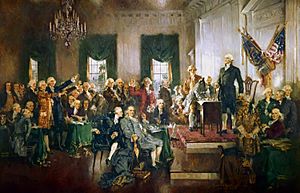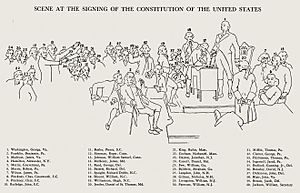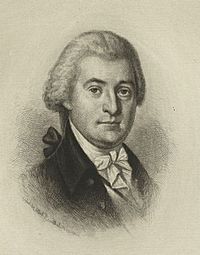William Blount facts for kids
Quick facts for kids
William Blount
|
|
|---|---|
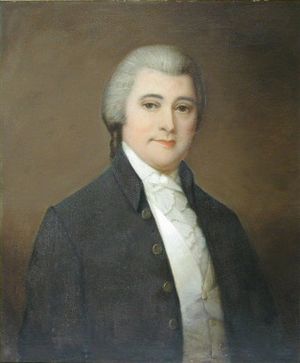 |
|
| Speaker of the Tennessee Senate | |
| In office 1798–1799 |
|
| Preceded by | James White |
| Succeeded by | Alexander Outlaw |
| United States Senator from Tennessee |
|
| In office March 30, 1796 – July 8, 1797 |
|
| Preceded by | Himself (Shadow Senator from the Southwest Territory) |
| Succeeded by | Joseph Anderson |
| United States Shadow Senator from the Southwest Territory |
|
| In office March 30, 1796 – August 2, 1796 |
|
| Preceded by | Seat established |
| Succeeded by | Himself (U.S. Senator from Tennessee) |
| Governor of the Southwest Territory | |
| In office September 20, 1790 – March 30, 1796 |
|
| Preceded by | Position established |
| Succeeded by | John Sevier (Tennessee) |
| Member of the Congress of the Confederation from North Carolina |
|
| In office 1786–1787 |
|
| In office 1782–1783 |
|
| Personal details | |
| Born | April 6, 1749 (March 26, 1749 (O.S.)) Windsor, North Carolina, British America |
| Died | March 21, 1800 (aged 50) Knoxville, Tennessee, U.S. |
| Resting place | First Presbyterian Church Cemetery |
| Political party | Democratic-Republican |
| Spouse | Mary Grainger |
| Relatives |
|
| Signature | |
William Blount (March 26, 1749 – March 21, 1800) was an important American leader and land investor. He was one of the Founding Fathers and signed the U.S. Constitution. Blount helped North Carolina approve the Constitution in 1789.
He was the only governor of the Southwest Territory. He played a big part in helping this territory become the state of Tennessee. In 1796, he was chosen as one of Tennessee's first U.S. Senators. However, he was later removed from the Senate in 1797 due to a secret plan he was involved in. Even after this, Blount remained very popular in Tennessee. He served in the state senate during his last years.
Contents
Early Life and Family
William Blount was born in North Carolina on March 26, 1749. His family was well-known and had built up a lot of wealth. William was the oldest of eight children born to Jacob and Barbara Gray Blount.
William and his brothers did not go to formal schools much. Instead, they learned about business from their father. Jacob Blount ran a large farm where he raised animals and grew crops like cotton and tobacco. He also made turpentine and ran a mill. His father bought thousands of acres of land, which taught William about making money from land deals.
During a time of unrest in North Carolina in the late 1760s, called the Regulator Movement, the Blount family supported the government. William and his brothers even joined the governor's army, though they did not see much fighting.
Role in the American Revolution
As tensions grew between Britain and the American colonies, the Blount family sided with the American Patriots. In 1776, William Blount became a paymaster for the North Carolina militia. This meant he was in charge of paying soldiers. His brothers also joined the Continental Army.
The Blount family helped the army by providing supplies. This was good for them financially and politically. They also started looking at lands to the west, beyond the Appalachian Mountains.
In 1777, Blount joined a unit marching north to help George Washington defend Philadelphia. Later, he helped organize troops to defend Charleston. His brother, Thomas, was captured when Charleston fell to the British in 1780. William Blount was also present at the Battle of Camden, where he lost a large sum of money meant for soldiers' pay.
North Carolina Politics and Congress
In 1781, William Blount was elected to the North Carolina House of Commons. He had won a close election after a previous one was canceled due to voting issues.
In 1782, Blount was chosen as one of North Carolina's delegates to the Continental Congress. He helped make decisions about taxes and the army. He also agreed to consider giving western lands to the new United States government to help pay off North Carolina's debts.
After leaving Congress, Blount returned to the North Carolina House of Commons. There, he helped pass important laws for the western lands that would become Tennessee. One law, called the "Land Grab Act," opened up western lands for settlement. Another law gave land to soldiers who had served in the war. These laws helped people like James White, who founded Knoxville, Tennessee. In 1784, Blount also helped establish the city of Nashville.
In 1784, Blount supported a bill to give North Carolina's western lands to the Continental Congress. This was a big debate, and the bill was later canceled. However, it led to a group of settlers in the Tennessee Valley trying to form their own state called the State of Franklin. Blount tried to stay neutral in this conflict.
Blount was elected to the Continental Congress again in 1785 and 1786. He also attended the Constitutional Convention in Philadelphia in 1787. He signed the new U.S. Constitution, believing it would benefit North Carolina.
After the Convention, Blount worked hard to convince North Carolina to approve the new Constitution. He was elected to the North Carolina Senate in 1788 and 1789. Thanks to his efforts, North Carolina finally approved the Constitution in November 1789. Soon after, the state gave its western lands to the new federal government.
Governing the Southwest Territory
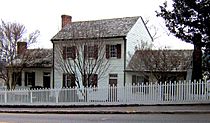
On April 2, 1790, Congress accepted North Carolina's western lands, which became the Southwest Territory. On June 8, President George Washington appointed William Blount as the governor of this new territory. Blount set up a temporary capital at Rocky Mount in what is now Piney Flats, Tennessee. He began organizing the government.
At first, settlers in the west were unsure about Blount because he seemed like someone from the East. But Blount earned their trust by appointing popular local leaders like John Sevier and James Robertson to important positions. He also hired his half-brother, Willie Blount, as his personal secretary. Blount also helped start the territory's first newspaper, the Gazette.
In 1791, Blount chose James White's Fort as the new capital. He named it "Knoxville" after Henry Knox, the U.S. Secretary of War. Blount then started building his own home, Blount Mansion, in the city.
As governor, Blount faced challenges. Western settlers wanted to fight Native American tribes, but the War Department in Washington wanted peaceful talks. In 1791, Blount signed the Treaty of Holston with Cherokee leaders. This treaty settled some land claims and allowed a road to be built. However, attacks from some Cherokee groups continued.
Settlers demanded federal troops, but the War Department blamed the settlers for moving onto Native American lands. Blount tried to calm things down, but after more attacks, he called up the militia. John Sevier led the militia to attack some Native American villages. The War Department was unhappy with Blount for this. Blount eventually negotiated a truce with the Cherokee in 1794.
Blount also worked to help the territory become a state. He held elections for a legislature in 1794. In 1795, a census showed the territory had enough people (77,000) to become a state. Blount then called for a state constitutional convention in Knoxville in January 1796. He attended this convention himself.
The new state government met in March 1796, even before it was officially a state. Blount knew he probably couldn't win the governor's race against Sevier. So, he sought one of Tennessee's two U.S. Senate seats instead. He was appointed Senator on March 30, 1796. He then went to Philadelphia to help Tennessee become a state. With help from his brother Thomas and James Madison, Tennessee was officially admitted to the Union on May 31, 1796.
The Blount Conspiracy and Removal
William Blount and his brothers had bought millions of acres of land in the western territories. They bought much of this land using borrowed money, which put them deeply in debt. In 1795, the value of western lands dropped sharply, causing financial problems for many land investors, including Blount.
At this time, there was a fear that France might take control of Spanish-held Louisiana. This would block American access to the Mississippi River, which was important for trade. To prevent this, Blount and a friend, John Chisholm, came up with a secret plan. They wanted Britain to take control of Florida and Louisiana. In return, American traders would get free access to New Orleans and the Mississippi River. Their plan involved territorial militias helping the British fleet attack Spanish-controlled areas.
In April 1797, a letter from Blount outlining this secret plan was discovered by a government agent. The agent sent the letter to Colonel David Henley, who then sent it to Timothy Pickering, the Secretary of War. Pickering, who did not like Blount, quickly sent the letter to President John Adams.
President Adams sent Blount's letter to the Senate on July 3, 1797. When Blount returned to the Senate, the letter was read aloud. Blount was shocked. He denied writing the letter and asked for more time. The Senate formed a committee to investigate. Blount tried to leave by ship, but federal officers stopped him. He later testified before the committee, still denying he wrote the letter.
On July 8, the House of Representatives voted to start hearings to remove Blount from his position. The Senate then voted to remove him from his seat, effectively expelling him. Blount posted bail and returned to Tennessee.
The Senate continued to investigate. Blount refused to attend the trial. His lawyers argued that the Senate did not have the power to remove a senator in this way. On January 11, 1799, the Senate voted to dismiss the case, saying they did not have the power to remove a senator. This decision made it unclear exactly how senators could be removed in the future.
This secret plan ruined Blount's reputation at the national level. Many important figures, like George Washington, were very critical of him.
Later Life and Legacy
Even though his national reputation was damaged, William Blount remained very popular in Tennessee. When he returned to Knoxville in September 1797, he was welcomed with a parade. Many of his friends and allies, including Andrew Jackson, remained loyal to him. Blount continued to support the interests of the western settlers.
In 1798, Blount was elected to the state senate for Knox County. On December 3, he was chosen as the Speaker of the Senate. He continued to work for the interests of Tennessee.
In March 1800, an illness spread through Knoxville. Blount became sick while caring for his family. He died on March 21, 1800. He was buried at the First Presbyterian Church Cemetery in Knoxville. His half-brother, Willie, took care of his family's estate and his children's education.
Many places are named after William Blount. These include Blount County, Tennessee, and the town of Blountville. Grainger County and Maryville are named after his wife, Mary Grainger Blount. William Blount High School and Mary Blount Elementary School are also named after them. Blount County, Alabama, is named after his half-brother, Willie Blount.
Blount's home, Blount Mansion, is still in Knoxville and is now a museum. It is a National Historic Landmark. A statue of Blount is in "Signers' Hall" at the National Constitution Center in Philadelphia. A plaque in the North Carolina State Capitol honors Blount as one of the state's signers of the Constitution.
Family
William Blount's father, Jacob, had eight children with his first wife, Barbara Gray. These included William, John Gray, Reading, and Thomas. After Barbara's death, Jacob married Hannah Salter and had five more children, including Willie and Sharpe. Thomas Blount later served in the U.S. House of Representatives. Willie Blount became governor of Tennessee from 1809 to 1815.
William Blount married Mary Grainger in 1778. They had six children: Ann, Mary Louisa, William Grainger, Richard Blackledge, Barbara, and Eliza. William Grainger Blount represented Tennessee in the U.S. House of Representatives from 1815 to 1819. Mary Louisa Blount married Congressman Pleasant Miller. Barbara Blount married General Edmund P. Gaines.
See also
 In Spanish: William Blount para niños
In Spanish: William Blount para niños



